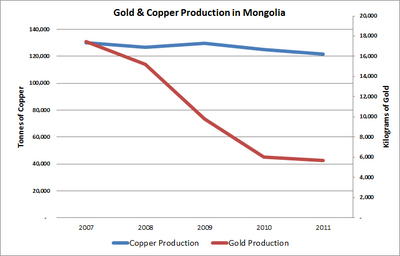
Mining is important to the national economy of Mongolia. Mongolia is one of the 29 resource-rich developing countries identified by the International Monetary Fund[1] and exploration of copper and coal deposits are generating substantial additional revenue.[2]
As of 2023, only 45% of Mongolian territory had been mapped geologically at a 150,000 scale.[3]
Coal, copper, and gold are the principal reserves mined in Mongolia. Several gold mines are located about 110 kilometres (68 mi) north of Ulaanbaatar, such as Boroo Gold Mine and Gatsuurt Gold Mine. Khotgor Coal Mine is an open-pit coal mining site about 120 kilometres (75 mi) west of Ulaangom. Ömnögovi Province in the south of Mongolia is home to large scale mining projects such as the Tavan Tolgoi coal mine and the Oyu Tolgoi copper mine. Oyu Tolgoi mine is reported to have the potential to boost the national economy by a third but is subject to dispute over how the profits should be shared. The International Monetary Fund (IMF) has estimated that 71 percent of the income from the mine would go to Mongolia.[4]
Mongolia Energy Corporation, a mining and energy company operating in Mongolia and Xinjiang and Erdenet Mining Corporation, a joint Mongolian-Russian venture, account for a large percentage of the mining in the country, but Anglo-Australian companies such as Rio Tinto and Canadian companies such as Turquoise Hill Resources are active in the country and have agreements with the government. The government institution responsible for overseeing mining development in the country is the Mineral Resource Authority of Mongolia (MRAM).
- ^ "Macroeconomic Policy Frameworks for Resource-Rich Developing Countries". Policy Papers. 2012 (70). 2012-08-24. doi:10.5089/9781498339995.007. ISSN 2663-3493.
- ^ Lkhagva, Davaajargal; Wang, Zheng; Liu, Changxin (2019-05-29). "Mining Booms and Sustainable Economic Growth in Mongolia—Empirical Result from Recursive Dynamic CGE Model". Economies. 7 (2): 51. doi:10.3390/economies7020051. hdl:10419/256983. ISSN 2227-7099.
- ^ Adiya, Amar (2023-10-30). "Mongolia at a Crossroads for its Critical Mineral Future". Mongolia Weekly. Retrieved 2023-11-20.
- ^ "Dividing up Mongolia's mining riches from Oyu Tolgoi". BBC. 27 March 2013. Retrieved 12 May 2013.